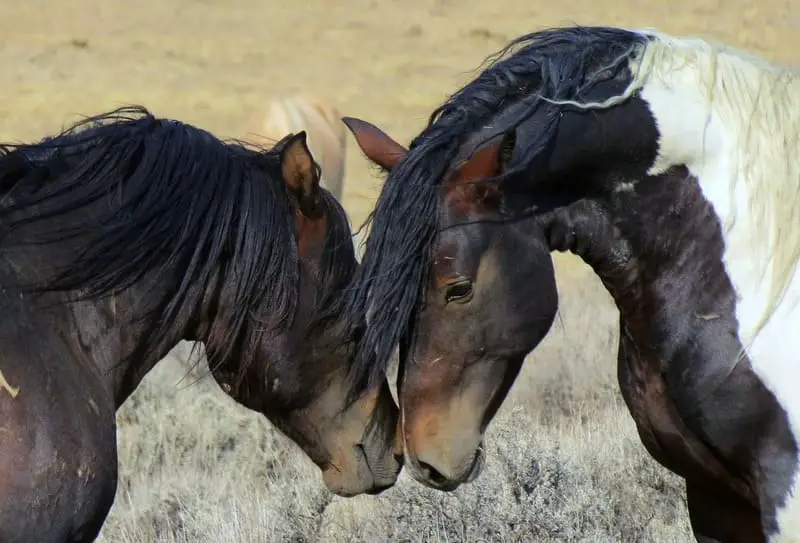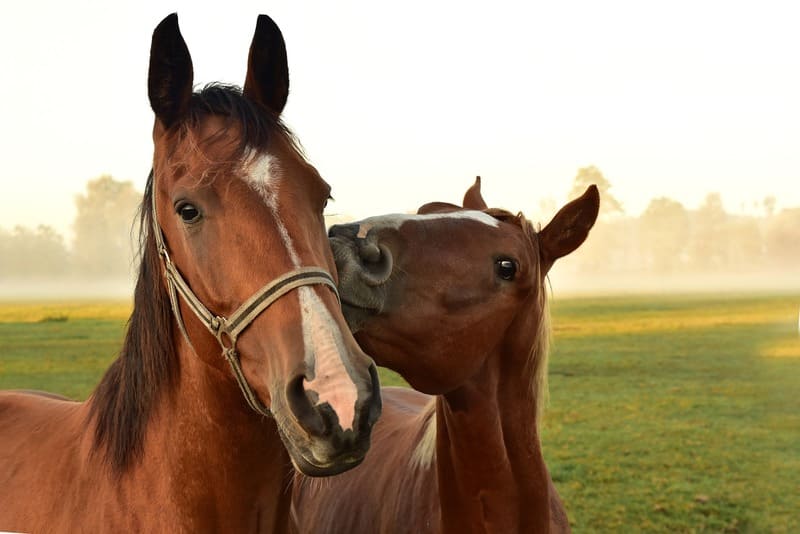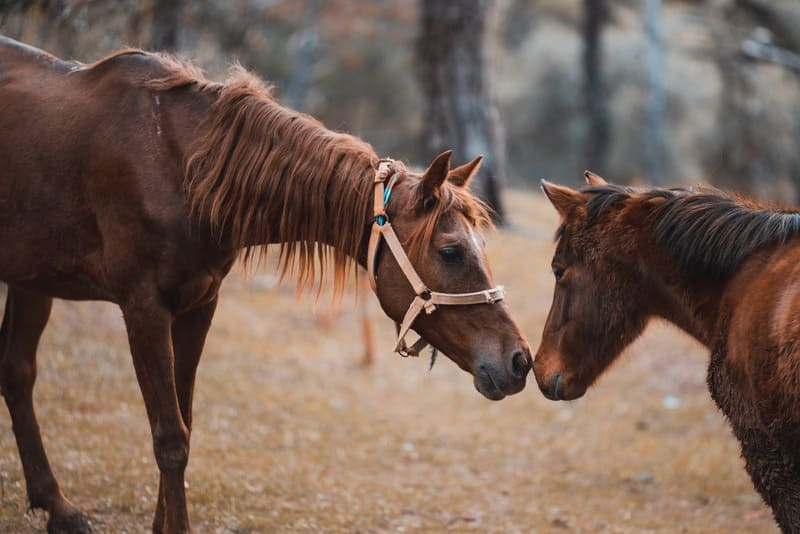Horses are fascinating creatures known for their grace, strength, and social behaviors. While they may not communicate with spoken words like humans, horses possess a complex system of communication that allows them to convey information, emotions, and intentions to one another. In this article, we will explore the various ways in which horses communicate and discuss the significance of their non-verbal language in their social structure and survival.

The Basics of Horse Communication
Horses are highly social animals that rely on communication to establish and maintain relationships within their herd. Their communication methods are primarily non-verbal and include body language, vocalizations, and other subtle cues. These forms of communication are crucial for their social interactions, hierarchy establishment, and even for their survival in the wild.
Body Language
Body language is one of the most fundamental ways in which horses communicate with one another. They use various postures, movements, and facial expressions to convey information and emotions. Here are some key elements of horse body language:
1. Ears
Horses’ ears are incredibly expressive and play a significant role in their communication. Ears held forward often indicate alertness or interest, while ears laid back can signal irritation, aggression, or discomfort. When one ear is forward and the other is back, it may suggest that the horse is listening to something specific in different directions.
2. Tail
The position and movement of a horse’s tail can also reveal much about its emotional state. A raised tail may indicate excitement or happiness, while a tucked tail can signify fear or submission. Rapid tail swishing can be a sign of irritation or discomfort.
3. Head and Neck
The position of a horse’s head and neck can convey its mood and intentions. For instance, a lowered head and relaxed neck muscles often signal relaxation and contentment, while a raised head and tense neck muscles can indicate alertness, tension, or aggression.
4. Body Posture
Horses use their overall body posture to express dominance, submission, or neutrality. A dominant horse may puff up its chest and stand tall to appear larger, while a submissive horse may lower its head, hunch its back, and yield to a more dominant horse.
Vocalizations
While horses are not as vocal as some other animals, they do produce a range of vocalizations to communicate. Some common horse vocalizations include:
1. Neighing
A neigh, or whinny, is a loud and high-pitched vocalization often used to communicate over a distance. Horses may neigh to announce their presence, express excitement, or locate other herd members.
2. Nicker
A nicker is a softer and lower-pitched vocalization used for more close-range communication. Horses often nickering to their foals, stablemates, or caretakers as a friendly greeting or when seeking attention.
3. Snorting
A snort is a sharp and forceful exhalation through the nostrils, often used to express alarm, surprise, or anxiety. It can be a warning signal to other horses, indicating potential danger.
Smell and Scent Marking
Horses also use their sense of smell to communicate. They have a highly developed olfactory system and can detect pheromones and other chemical signals. In the wild, horses may use urine and feces to mark their territory and communicate their presence to other herds or potential mates. This chemical communication can convey information about a horse’s age, sex, and reproductive status.

Social Hierarchy and Communication
The intricate communication among horses plays a crucial role in establishing and maintaining their social hierarchy within a herd. Horses are social animals with a clear pecking order, and effective communication helps prevent physical confrontations and promotes stability within the group.
Dominance and Submission
Horses use body language and subtle cues to establish dominance and submission. Dominant horses will often assert themselves through dominant postures and movements, while submissive horses will yield and display signs of deference. This communication helps maintain order within the herd, reducing the need for physical aggression.
Aggression and Play
Horses also use their communication skills to convey their intentions during moments of aggression and play. This is particularly important in minimizing the risk of injury during interactions. Clear signals of aggression may involve pinned ears, bared teeth, and threatening movements, while play can be signified by more relaxed postures and inviting gestures.
Protecting the Herd
Communication is vital when it comes to protecting the herd from potential threats. Horses will often use vocalizations and visual cues to alert the group to the presence of a predator. These signals can trigger a coordinated response in which the herd members flee or confront the threat together.
Communication in Different Settings
The way horses communicate can vary depending on their environment and circumstances. For instance, the communication patterns of domesticated horses may differ from those of wild horses. Let’s explore these differences.
Wild Horses
Wild horses, such as mustangs, rely heavily on non-verbal communication to navigate their natural environment. In the wild, the ability to communicate effectively is essential for their survival. They must convey information about food sources, water locations, and potential threats. Wild horse herds are typically organized in a matriarchal structure, and the dominant mare often leads the group, relying on clear and effective communication to keep the herd safe.
Domesticated Horses
Domesticated horses have adapted their communication patterns to life in captivity and interaction with humans. While they still use body language and vocalizations to communicate with other horses, they must also understand and respond to human cues and commands. Training and socialization can impact the way domesticated horses communicate. They may learn to tolerate situations that wild horses would perceive as threats or stressors.
Can Horses Communicate with Humans?
Horses not only communicate with each other but also with humans. Humans and horses have a long history of cooperation, and this communication between species has been a fundamental aspect of their shared history.
Understanding Human Cues
Horses are remarkably adept at reading human body language and cues. They can pick up on the slightest changes in a person’s posture, movements, and tone of voice. This ability to interpret human signals is crucial for their interactions with handlers, riders, and caretakers. It allows them to respond to commands and cues during training and other activities.
Emotional Bond
Horses can also form emotional bonds with humans. These bonds are often built on trust and consistent, positive interactions. Many horse owners and riders have experienced the deep connection that can develop between a horse and a human, and this is largely due to effective communication and mutual understanding.
Equine-Assisted Therapy
Horses’ ability to connect with humans has led to the development of equine-assisted therapy and therapeutic riding programs. In these settings, horses can provide emotional support, improve confidence, and help individuals overcome various challenges. The success of such programs is rooted in the unique bond and communication that can be established between horses and humans.

The Role of Communication in Training
Effective communication is central to training horses for various purposes, including riding, working, and competing. It’s important to understand the principles of horse communication to ensure the safety and well-being of both the horse and the human involved.
Positive Reinforcement
One of the most effective training methods for horses is positive reinforcement. This approach involves rewarding desired behaviors with treats, praise, or affection. Horses quickly learn to associate the desired behavior with a positive outcome, making it more likely that they will repeat that behavior. Positive reinforcement is based on clear communication and mutual understanding.
Body Language
Trainers and riders must be acutely aware of their own body language when working with horses. Horses can pick up on subtle cues and emotions, so it’s essential to maintain a calm and confident demeanor. Inconsistent or confusing signals can lead to miscommunication and misunderstandings.
Vocal Cues
Voice commands can be a valuable tool in horse training. Horses can learn to respond to verbal cues, such as “walk,” “trot,” or “whoa.” However, consistency in the use of vocal cues is crucial, as horses associate specific words or phrases with certain actions. Clear and consistent communication helps horses understand what is expected of them.
Timing
Timing is critical in horse training. Horses learn best when the reward or correction is delivered immediately after the desired behavior or undesired behavior. The timing of the communication helps horses connect their actions with the consequences, facilitating learning.
The Significance of Horse Communication
Understanding the intricacies of horse communication is not only essential for those who work with horses but also sheds light on the remarkable nature of these animals and their unique social structure.
Evolutionary Significance
Horse communication has evolved over thousands of years to help them survive in the wild. The ability to convey information about food, water, and danger has been crucial to their success as a species. Additionally, the establishment of social hierarchies through communication has ensured efficient cooperation within their herds.
Bonds and Relationships
Communication is also at the heart of the bonds and relationships horses form with one another and with humans. These connections can be deeply rewarding for both horses and humans, leading to companionship, trust, and mutual support.
Human-Horse Partnership
The partnership between humans and horses, built on effective communication, has played a significant role in human history. Horses have been essential in transportation, agriculture, and warfare, and they continue to be valuable in various equestrian sports and activities.
Preservation of Natural Behavior
Understanding horse communication allows us to interact with these animals while respecting their natural behavior and instincts. It enables us to meet their needs and ensure their well-being, whether they are used for work, sport, or companionship.
Conclusion
Horses are excellent communicators, relying on a combination of body language, vocalizations, and other cues to convey information, emotions, and intentions to one another. This form of communication is fundamental to their survival in the wild and their social structure within a herd. It also enables them to form deep bonds with humans, making them invaluable partners in various aspects of human life.
While horses may not “talk” in the way humans do, their ability to communicate effectively through non-verbal means demonstrates the depth of their social intelligence and the significance of their unique language. Understanding and respecting horse communication is crucial for anyone working with these magnificent animals, as it not only enhances the training process but also promotes the well-being of horses and strengthens the human-horse bond.
In essence, horses do talk to one another and to humans, just not in words. Their language is one of subtlety and nuance, shaped by thousands of years of evolution and partnership with humans, making them truly remarkable creatures in the world of animal communication.
